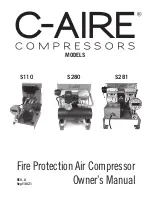
SB-170-9 RUS
39
SB-170-9
25
5.4.2 CM-SW-01
Standard for all CSW105 compressors
The compressor module integrates the entire electronic
periphery of the compressor: It allows monitoring the
essential operating parameters of the compressor: mo-
tor and discharge gas temperature, phase and rotation
direction monitoring, oil supply and application limits
and thus protects the compressor from operation under
critical conditions. For further information, see Tech-
nical Information ST-150.
!
!
NOTICE
The compressor module may be damaged or
fail!
Never apply any voltage to the terminals of CN7
to CN12 – not even for test purposes!
The voltage applied to the terminals of CN13
must not exceed 10 V!
The voltage applied to terminal 3 of CN14 must
not exceed 24 V! Do no apply voltage to the
other terminals!
The following components are completely installed and
wired in the state of delivery:
• Slider position indicator.
• Oil monitoring (OLC-D1).
• Solenoid valves for capacity control and V
i
.
• Discharge gas temperature sensor.
• Low pressure and high pressure transmitter.
Modification to these components or their wiring is not
required and should not be done without consulting
BITZER.
The following components are not installed and wired in
the state of delivery and need to be connected:
• Motor temperature monitoring (PTC sensor in motor
winding).
• Phase monitoring (in case of a phase failure or inad-
missibly high phase asymmetry).
The compressor module internally supplies voltage to
the peripheral devices (solenoid valves, oil monitoring
device and slider position indicator) and to the terminal
strips CN7 to CN12.
Please refer to the Technical Information ST-150 for in-
formation on all connections.
5.4.3 SE-i1
This protection device with extended monitoring func-
tions can be used as an option for all HS.53 .. HS.85
compressors and CSH and CSW compressors.
Monitoring functions:
• Temperature monitoring.
• Monitoring of the PTC control circuit to detect any
short-circuit or line break/sensor failure.
• Rotation direction monitoring.
• Monitoring of phase failure and asymmetry.
• Monitoring of the maximum cycling rate.
For further information, see Technical Information
CT-110.
5.4.4 SE-E2
Optional protection device for operation with frequency
inverter and soft starter (for a ramp time shorter than
1 s).
• Dimensions and integration in the control identical to
SE-E1.
• Suitable for all CS. compressors.
• Monitoring functions are basically identical to those
of SE-E1. However, the SE-E2 monitors phase fail-
ure during the entire running time of the compressor.
For further information, see Technical Information
ST-122.
5.4.5 Monitoring of the oil circuit
• For short circuits without liquid injection (LI) for addi-
tional cooling and for small system volume and small
refrigerant charge: Indirect monitoring with oil tem-
perature sensor (standard)
!
!
NOTICE
Lack of oil leads to a too high increase in tem-
perature.
Risk of damage to the compressor!
• For circuits with liquid injection (LI) for additional
cooling and / or for great system volume as well as
parallel compounding: Monitor oil level directly with
opto-electronic oil level monitoring (option), see
chapter Opto-electronic oil level monitoring OLC-D1-
S, page 26. The connection is on the compressor
housing, see chapter Connections and dimensional
drawings, page 14, position 8.
SB-170-9
39
3.1 Economiser und Zusatzkühlung
Die Verdichter CSH65 bis CSH95 haben einen Econo-
miseranschluss ECO, der im ganzen Regelbereich der
Leistungsregelung aktiv ist. Sie haben ebenfalls An-
schlüsse für externe Ölkühlung und für Flüssig-
keitseinspritzung LI.
Die Verdichter CSW65 bis CSW105 und CSH76 bis
CSH96 haben einen ECO, der nur bei Volllast aktiv ist.
Sie haben keine Anschlüsse für Zusatzkühlung.
Die Verdichter CSK6151 und CSK6161 haben aus pro-
duktionstechnischen Gründen Anschlüsse für ECO und
LI, die nicht für den Einsatz freigegeben sind.
Diese Anschlüsse werden in naher Zukunft nicht mehr
zur Verfügung stehen.
3.2 Einsatz von brennbaren Kältemitteln der
Sicherheitsgruppe A2L (z. B. R1234yf)
Information
Die Angaben in diesem Kapitel zum Einsatz von
Kältemitteln der Sicherheitsgruppe A2L bezie-
hen sich auf europäische Vorschriften und
Richtlinien. In Regionen außerhalb der EU die
dort geltenden länderspezifischen Vorschriften
beachten.
Information
Für Kältemittel der Sicherheitsgruppe A3, wie
R290 Propan oder R1270 Propylen, sind eigene
Verdichterausführungen auf Anfrage lieferbar.
Dafür ist eine zusätzliche Betriebsanleitung zu
berücksichtigen.
Dieses Kapitel beschreibt die vom Verdichter beim Ein-
satz von Kältemitteln der Sicherheitsklasse A2L ausge-
henden zusätzlichen Restrisiken und gibt Erläuterun-
gen dazu. Diese Informationen dienen dem Anlagen-
hersteller für die von ihm auszuführende Risikobewer-
tung der Anlage. Diese Informationen können in keiner
Weise die Risikobewertung für die Anlage ersetzen.
Bei der Ausführung, der Wartung und dem Betrieb von
Kälteanlagen mit brennbaren Kältemitteln der Sicher-
heitsgruppe A2L gelten besondere Sicherheitsbestim-
mungen.
Die Verdichter sind bei Installation entsprechend dieser
Betriebsanleitung im Normalbetrieb ohne Fehlfunktion
frei von Zündquellen, die die brennbaren Kältemittel
R1234yf und R1234ze(E) entzünden können. Sie gel-
ten als technisch dicht. Für andere Kältemittel der Si-
cherheitsgruppe A2L liegen keine Zündquellenbewer-
tungen vor. Daher muss bei diesen das Schutzgerät
außerhalb des Anschlusskastens, z. B. im Schalt-
schrank, untergebracht werden, bis spezifische Freiga-
ben vorhanden sind.
Information
Bei Einsatz eines brennbaren Kältemittels:
Warnzeichen "Warnung vor feuergefährlichen
Stoffen" (W021 nach ISO7010) gut sichtbar am
Verdichter anbringen. Ein Aufkleber dieses
Warnzeichens ist der Betriebsanleitung beige-
legt.
Die Verbrennung von Kältemittel im Anschlusskasten
kann nur bei gleichzeitigem Auftreten mehrerer sehr
seltener Fehler geschehen. Die Wahrscheinlichkeit da-
für ist als äußerst gering einzuschätzen. Bei Verdacht
auf verbranntes Kältemittel im Anschlusskasten vor
dem Öffnen mindestens 30 Minuten warten. In dieser
Zeit sind nach dem aktuellen Stand der Erkenntnisse
die giftigen Verbrennungsprodukte abgebaut. Die Ver-
wendung von geeigneten, säurefesten Handschuhen
ist erforderlich. Feuchte Rückstände nicht berühren
sondern trocknen lassen, da sie gelöste giftige Stoffe
enthalten können. Verdampfungsprodukte keinesfalls
einatmen. Betroffene Teile durch ausgebildetes Fach-
personal reinigen lassen bzw. im Falle von Korrosion
sind die betroffenen Teile fachgerecht zu entsorgen.
4 Montage
4.1 Verdichter transportieren
Verdichter entweder verschraubt auf der Palette trans-
portieren oder an Transportösen anheben, CS.95 und
CSW105 nur mit Traverse anheben, siehe Abbildung 1,
Seite 40.
Gewicht 1200 .. 1900 kg (je nach Typ)
GEFAHR
Schwebende Last!
Nicht unter die Maschine treten!
















































